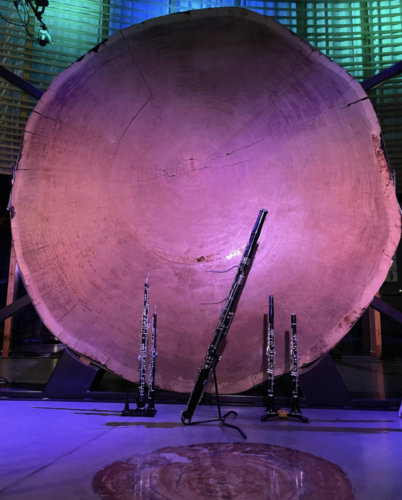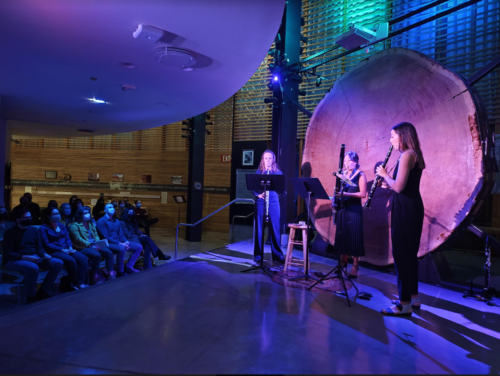![]()
![]()
![]()

Sara Fraker is an interdisciplinary creator, educator, and musician who channels her passions for music and ecology through teaching, performance, and creative collaborations. In addition to being an associate professor at the University of Arizona Fred Fox School of Music, she maintains an active performance career as a member of the Tucson Symphony Orchestra and True Concord Voices & Orchestra. Her most recent project, Tree-Ring Music, engages at the intersections of climate science and music. She worked with dendroecologist Dr. Margaret Evans of UArizona’s Laboratory of Tree-Ring Research and composer Lachlan Skipworth, who created a piece for reed trio and electronics inspired by tree-ring growth data. Another interdisciplinary project, Braiding for oboe and electronics, was a collaboration with composer Asha Srinivasan and ecologist Robin Wall Kimmerer (author of Braiding Sweetgrass), exploring themes of plant ecology, animacy and traditional ecological knowledge (TEK).
We talked to Sara recently to learn more about her work in research, music, and tree-rings.
![]() ClimateMusic: When and how did you begin playing the oboe? What incentivized you to pursue professional musicianship and music education?
ClimateMusic: When and how did you begin playing the oboe? What incentivized you to pursue professional musicianship and music education?
SF: I started playing the oboe when I was 9 years old. I come from a very musical family but never intended to pursue music professionally. I got serious about my oboe studies at the end of high school and beginning of college, when I was about 17. Suddenly, growing as a musician became the focus of my life.
ClimateMusic: How did you first become interested in ecology, climate change, and TEK, and what made you want to incorporate these relevant and important environmental themes into your work as an oboist?
SF: I’ve been interested in ecology since I was a child, and always thought I would pursue a career in biological science. Once I became established in my musical career and had the freedom to pursue my own creative projects, there was no question that these concerns would become a huge part of my work.
ClimateMusic: You’ve noted the necessity of combining artistic and scientific approaches to address contemporary crises, such as the environmental crisis. Why do you think this is crucial to fighting the climate crisis? What unique perspectives can music and science bring to the table when combined that the two fields cannot achieve alone?
SF: The climate crisis isn’t a crisis of knowledge, it’s a crisis of political will. The arts are all about connection and storytelling, which are the balms we need to address our environmental crises and the brokenness of our economic systems. Artists feel compelled to address the most pressing issues of their times, so naturally there are many of us who must speak to the climate crisis through our art. Specifically, music has a communicative power that is emotionally direct and representational beyond images and language. The ecological harms we are perpetuating can only be healed through relationship, which is why the arts are so crucial.

ClimateMusic: Dr. Robin Wall Kimmerer’s book, Braiding Sweetgrass: Indigenous Wisdom, Scientific Knowledge and the Teachings of Plants inspired your collaboration with composer Asha Srinivasan in creating Braiding. Could you elaborate on what it was about Braiding Sweetgrass that sparked your desire to perform a related oboe piece? What was the process of collaborating on composition and performing like for you, and what did you learn from the process?
SF: I heard a radio interview with Dr. Kimmerer when her book first came out in 2014. When I learned about her ideas on the animacy of the natural world, I just knew these concepts could be represented powerfully in music. Music is simply sound in motion through time, and I imagined a piece in which the animacy of musical sound became the animacy of nature. I went out and read Braiding Sweetgrass immediately, and loved every page of it. Once I had connected with Robin and Asha over email, Asha and I both did close readings of the text, with a musical piece in mind. After teasing out the images that resonated with both of us, Asha gave the piece its form and content. One of the main ideas of Braiding is reciprocity, and the music itself is an offering to the Dalbergia Nation, the very trees that give the wooden oboe its body and voice (Dalbergia is the genus name for the tropical hardwoods harvested to make the oboe). Asha created a gorgeous fixed track of electronic and natural sounds: a tree crackling as it is cut down, wind chimes, insects and birds. She composed the oboe line to interact with these sounds, and it is such a fun piece to perform! The collaboration was a beautiful process, culminating in the live premiere in Tucson when we all met in person for the first time. I was able to accompany Dr. Kimmerer on a visit to the Tohono O’odham Nation, where we spent the day with ethnobiologists and Native college students, exploring the plants of our Sonoran Desert.
ClimateMusic: How has TEK shaped your understanding of ecology, environmental science and sustainability? Why is understanding TEK and learning from indigeneous knowledge important to you?
SF: In my opinion, TEK is absolutely essential to survival and holds the keys to a sustainable future. There is tremendous wisdom and power in indigenous ways of knowing and ways of being in relationship to the land. The more hearts that open to healing our relationship with the land, the closer we’ll get to solving our most dire problems.
ClimateMusic: Can you tell us about your ongoing collaboration with composer Lachlan Skipworth in creating a reed trio piece inspired by tree-ring data and the climate crisis? What initiated your ideas for this project? What can we learn from the changes in tree-rings, and how do you incorporate this into the music?
SF: I was intrigued by the science being done at the Laboratory of Tree-Ring Research, which is the world’s largest center of tree-ring science. I was excited to make a connection with the ground-breaking work being done right on our own campus at the University of Arizona. In meeting scientists at the Lab, I was excited to learn how much of their research is related to climate change. The medium of the reed trio (oboe/English horn, clarinet bassoon) felt so right for a tree-ring piece, because of the woody sound blend these instruments create together. I was also inspired by the gallery space at the Tree-Ring Lab, which features a fabulous acoustic AND a giant sequoia cross-section dated to 212 CE. The piece, entitled Pine Chant, was composed with this performance space in mind.
I knew a few of Lachlan’s pieces for wind instruments, and I felt that he was the right composer for this project. His talent for lyricism and texture is what drew me to his work. I proposed the reed trio instrumentation, but it was Lachlan who came up with the idea to create an “aura” of electronic sound that emanates from the acoustic notes we play. In order to render the data accurately, he created the musical score in an app that allows the performers to read three synchronized scrolling iPads. It’s a brilliant way to score for chamber music.
Tree-rings give us crucial information about climate conditions and forest health over hundreds and even thousands of years. Dr. Margaret Evans, my collaborator from the Lab, investigates carbon sequestration in forests and the complex interactions between forests and the carbon cycle. She provided us with USDA Forest Service data detailing the tree-ring growth of three tree species in Arizona (Ponderosa pine, Colorado pinyon, and Douglas-fir). Her team was interested in what this data tells us about synchronicity (if the trees have similar or dissimilar growth patterns) and forest resiliency. From this data, Lachlan selected 12 individual trees and used their tree-ring measurements to control various musical parameters. Beyond this data-driven aspect, however, he composed a harmonic basis for the piece that communicates a deep emotional response to climate change. It’s a stunning piece, an ingenious hybrid of scientific and musical expression. And the sound design creates a totally immersive experience.

ClimateMusic: In Braiding and your project based on tree ring data, the musical compositions involve both traditional instruments, as well as electronics. What does the process of integrating these two different types of sounds look like?
SF: The integration of acoustic and electronic sounds in these works presents the composers with so many possibilities for expression. In Braiding, Asha was able to create an entire soundscape of rich natural sounds, combined with electronic textures and the live acoustic oboe sound. She came up with such a rich and colorful palette of sounds. In Pine Chant, Lachlan used the electronics to create a spatial impression of echoing rings that sustain the harmonies and blur the textures. For us musicians, playing these pieces is a unique sensory experience, because the electronics augment our own instruments’ possibilities.
ClimateMusic: Where and how can we keep up with your exciting work?
SF: I’ll continue adding materials to my website as the Tree-Ring Music project progresses: www.sarafraker.com/tree-ring-music
The Braiding page of my website contains a conversation with Drs. Kimmerer and Srinivasan, as well as a CBC radio piece featuring the piece: www.sarafraker.com/braiding
And I often post about my projects on Instagram: @sara.fraker![]()